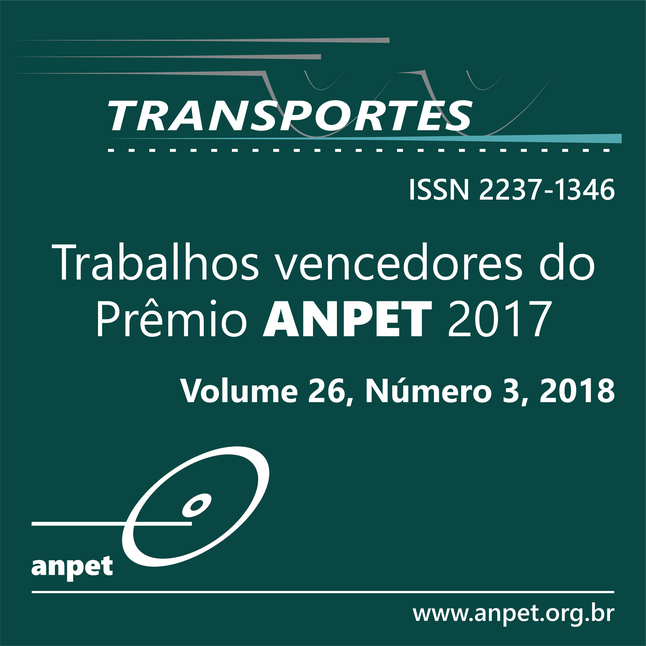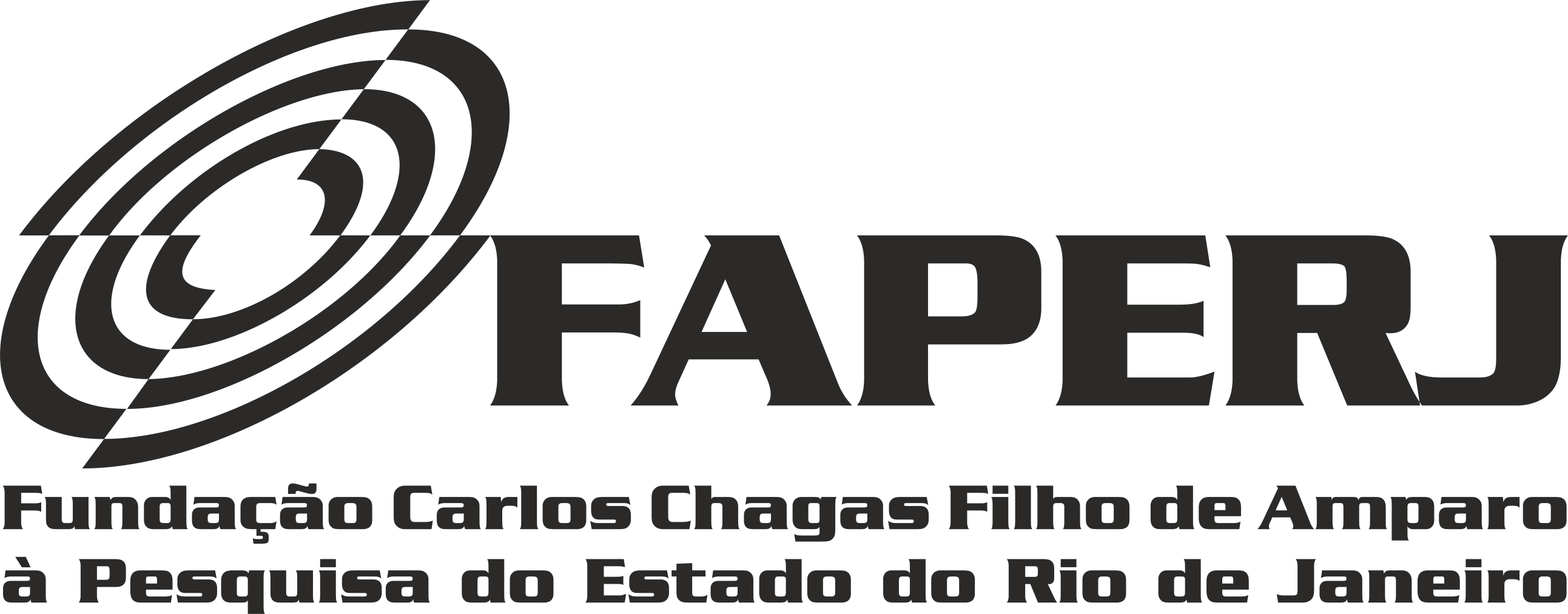Análise de desempenho de algoritmos de aprendizagem de máquinas para análise desagregada de viagens intermunicipais
DOI:
https://doi.org/10.14295/transportes.v26i3.1614Keywords:
Trip Distribution, Genetic Algorithms, Decision Tree, Gravitational Model.Abstract
This paper proposes a disaggregated analysis of intercity destination choices, through the application of Machine Learning (ML) algorithms (Classification And Regression Tree - CART and Genetic Algorithms - GA). An Origin-Destination Survey was carried out by the Center of Transportation and Environmental Studies (UFBA) in 2012/2013 in eleven municipalities in the state of Bahia, Brazil. It was carried out a calibration of a Multinomial Logit Model with GA algorithm, bringing the advantage of association of the destination choices to values of estimated coefficients of the random utility functions, without the problems related to the calibration of the traditional logit models, such as Irrelevant Alternatives (IIA) assumption. The performance of each ML algorithm was compared to a traditional approach (Gravitational Model). The results showed that the ML algorithms presented better predictions for destination choices, and GA presented advantages in obtaining the estimated parameters related to the covariates. The main conclusion is that such algorithms can be applied in trip distribution step, incorporating the effect of the disaggregated variables, without rigorous assumptions of the traditional disaggregated models.Downloads
References
Ben-Akiva, M.E.; Lerman, S.R. (1985) Discrete Choice Analysis: Theory and Application to Travel Demand. The MIT Press, Cam-bridge, MA.
Breiman, L.; Friedman, J.H; Olshen, R.A.; Stone, C.J. (1984) Classification and Regression Trees. Wadsworth International Group, Belmont, CA.
Carvalho, A. C. P. L. F.; Galvão, C. O.; Lacerda, E. G. M.; Diniz, L. S.; Valença, M. J. S.; Ludermir, T. B.; Vieira, V. P. P. B. (1999). Siste-mas inteligentes: Aplicações a recursos hídricos e ambientais. Porto Alegre: Editora Universidade/ UFRGS/ ABRH. ISBN 8570255276.
De Grange, L.; Fernández, E.; de Cea, J. (2010) A consolidated model of trip distribution. Transportation Research Part E: Lo-gistics and Transportation Review, v. 46, n. 1, p. 61–75. DOI: 10.1016/j.tre.2009.06.001
De Souza, A. D. (2017); Comparação de algoritmos de Aprendizagem de Máquinas para análise desagregada de viagens intermu-nicipais. 84 f. Dissertação de Mestrado. Departamento de Engenharia de Transporte. Escola de Engenharia de São Carlos.
Fotheringham, A.S. (1983) Some theoretical aspects of destination choice and their relevance to production-constrained gravity models. Environment and Planning A, v. 15, n. 8, p. 1121–1132. DOI: 10.1068/a151121
Ichikawa, S.M., Pitombo, C.S., Kawamoto, E. (2002) Aplicação de Minerador de dados na obtenção de relações entre padrões de viagens encadeadas e características socioeconômicas. Anais do XVI do Congresso de Pesquisa e Ensino em Transportes, Anpet, Natal (RN), v. 2, p. 175-186.
Kass, G.V. (1980) An exploratory technique for investigating large quantities of categorical data. Applied Statistics, v. 29, p. 119–127. DOI: 10.2307/2986296
Kononenko, I; Kukar, M. (2007) Machine Learning and Data Mining: Introduction to Principles and Algorithms. Horwood Pub-lishing. Chichester, UK.
Koppelman, F. S.; Wen, C.H. (2000) The paired combinatorial logit model: properties, estimation and application. Transporta-tion Research Part B: Methodological, v. 34, n. 2, p. 75-89. DOI: 10.1016/S0191-2615(99)00012-0
LaMondia, J.; Snell, T.; Bhat, C.R. (2009) Traveler Behavior and Values Analysis in the Context of Vacation Destination and Travel Mode Choices: A European Union Case Study. Transportation Research Record: Journal of the Transportation Re-search Board, n. 2156, p. 140-149. DOI: 10.3141/2156-16
Marsland, S. (2009) Machine Learning: An Algorithmic Perspective. CRC Press. Cambridge, UK.
Mozolin, M.; Thill, J.C.; Linn, U.E. (2015) Trip distribution forecasting with multilayer perceptron neural networks: A critical evaluation. Transportation Research Part B: Methodological, v. 34, p. 53-73. DOI: 10.1016/S0191-2615(99)00014-4
Omrani, H. (2015) Predicting travel mode of individuals by machine learning. 18th Euro Working Group on Transportation, EWGT 2015, p. 840-849.
Pitombo, C.S.; Kawamoto, E.; Sousa, A.J. (2011) An exploratory analysis of relationships between socioeconomic, land use, activity participation variables and travel patterns. Transport Policy, v. 18, p. 347-357. DOI: 10.1016/j.tranpol.2010.10.010
Pitombo, C.S.; Kawamoto, E.; Sousa, A.J. (2013) Linking activity participation, socioeconomic characteristics, land use and travel patterns: a comparison of industry and commerce sector workers. Journal of Transport Literature, v. 7, p. 59-86. DOI: 10.1590/s2238-10312013000300004
Pitombo, C. S.; De Souza, A.D.; Lindner, A. (2017) Comparing decision tree algorithms to estimate intercity trip distribution. Transportation Research Part C , v. 77, p. 16-32. DOI: 10.1016/j.trc.2017.01.009
Pulugurta S, Arun A, Errampalli M (2013) Use of Artificial Intelligence for Mode Choice Analysis and Comparison with Tradi-tional Multinomial Logit Model, Procedia - Social and Behavioral Sciences, v. 104, p. 583-592. DOI: 10.1016/ j. sbspro.2013.11.152
Quinlan, R. (1983) Learning efficient classification procedures and their application to chess end-games. Machine Learning: An Artificial Intelligence Approach, Tioga, Palo Alto, p. 463-482.
Rasouli, M.; Nikraz, H. (2013) Trip Distribution Modelling Using Neural Network. Transport Research Forum, Brisbane, Aus-tralia.
Wilson, A.A. (1967) Statistical Theory of Spatial Distribution Models. Transportation Research, v. 1, p. 253-269. DOI: 10.1016/0041-1647(67)90035-4
Xie, C.; Lu, J.; Parkany, E. (2003) Work travel mode choice modeling with data mining: decision trees and neural networks. Transportation Research Record: Journal of the Transportation Research Board, n. 1854, p. 50-61. DOI: 10.3141/1854-06
Yang, C.; Tsai, M.; Chang, C, 2014. Investigating the joint choice behavior of intercity transport mode and high-speed rail cabin with a strategy map. Journal of Advanced Transportation. DOI: 10.1002/atr.1264
Downloads
Published
How to Cite
Issue
Section
License
Authors who submit papers for publication by TRANSPORTES agree to the following terms:
- Authors retain copyright and grant TRANSPORTES the right of first publication with the work simultaneously licensed under a Creative Commons Attribution License that allows others to share the work with an acknowledgement of the work's authorship and initial publication in this journal.
- Authors may enter into separate, additional contractual arrangements for the non-exclusive distribution of this journal's published version of the work (e.g., post it to an institutional repository or publish it in a book), with an acknowledgement of its initial publication in TRANSPORTES.
- Authors are allowed and encouraged to post their work online (e.g., in institutional repositories or on their website) after publication of the article. Authors are encouraged to use links to TRANSPORTES (e.g., DOIs or direct links) when posting the article online, as TRANSPORTES is freely available to all readers.
- Authors have secured all necessary clearances and written permissions to published the work and grant copyright under the terms of this agreement. Furthermore, the authors assume full responsibility for any copyright infringements related to the article, exonerating ANPET and TRANSPORTES of any responsibility regarding copyright infringement.
- Authors assume full responsibility for the contents of the article submitted for review, including all necessary clearances for divulgation of data and results, exonerating ANPET and TRANSPORTES of any responsibility regarding to this aspect.









